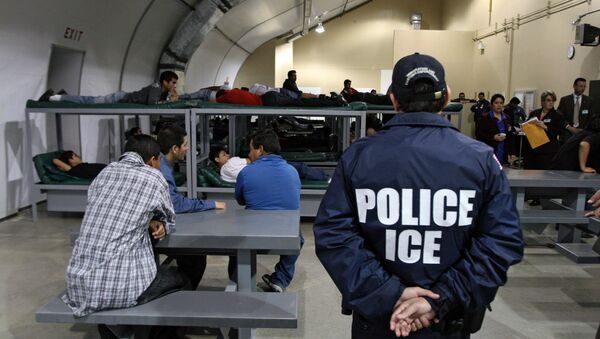Speaking with Eugene Puryear of Sputnik Radio's "By Any Means Necessary," Dr. Philip Stinson detailed the state of immigration enforcement in the first months of the Trump administration. Stinson is an associate professor of Criminal Justice at Bowling Green State University.
The question of whether the first months of Trump's presidency saw an increase in immigration arrests over the Obama years ended up being more complex that one might think. There has been "a relatively large increase, about 36 percent, in immigration arrests overall during the first 100 days of the Trump administration compared to the same time last year," Stinson said.
"But, that being said, while there is a significant increase, the levels Trump is arresting immigrants at now are actually still below what they were during most of the Obama administration. It wasn't until November 2014 when Obama's Department of Homeland Security decided to issue guidelines to ICE, prioritizing a certain subset of unauthorized or undocumented immigrants for arrest" that immigration arrests plummeted, according to Stinson.
Asked why Obama changed his policy nearly six years into his administration, Stinson explained that the Obama administration tried a strategy "in its quest to win what they call comprehensive immigration reform: their strategy was that we'll work with quote-unquote 'moderate Republicans' to push through immigration reform."
"And to do that, we'll appease the more hardcore wing of the party more hellbent on immigration enforcement by driving up the numbers, showing that we're serious about enforcing and hoping that this was good faith in enforcing federal law; that they'll come to the table and we can work out some kind of immigration reform package."
"Of course, that didn't happen," Stinson dryly remarked. "By militarizing the border and carrying out all these arrests it created the impression for people around the country that the border was out of control, that immigrants were taking over the country — the sort of narrative that is often projected on the far right. And that wing of the Republican party which they were hoping would sort of give in and compromise to these efforts never did."
"And so by November 2014 the Obama administration had seen this and decided for whatever reason to dial down its mass arrests of immigrants and focus more on recent border crossings and those with more high-level criminal histories."
Puryear wondered why Trump, who made stopping illegal immigration a centerpiece of his campaign, has yet to match the numbers of his predecessor, a nominally more liberal candidate. Stinson blamed logistics, and the obstacles placed in ICE's path by sanctuary cities.
"I think anything that gums up the works, be it at the initial arrest level, at the court level, at the final removal stage level, is what slows down ICE," he said. "Because when we think about, their mission is really to remove 11 million people plus those who are here without papers. That's a historically large logistical project.
"In order to actually carry this out, you need an intense amount of personnel working as efficiently as possible. Beyond just the sort of sense that people in L.A. might have about their rights, ICE has complained about state or local localities that refuse to cooperate with what they call local detainer requests."
A detainer request is when ICE or another enforcement agency asks local police precincts to hold an undocumented immigrant in one of their cells until ICE can retrieve, process and eventually deport them. "This is a controversial practice because they often ask to hold them after their release date," says Stinson.
However, Stinson does believe that it's only a matter of time before Trump's immigration arrest numbers exceed the highs of the Obama years. "It takes a little while to rev up their engine, but they're well on their own way. We shouldn't sit back and say 'oh, it's the same thing.' ICE seems intent on building their capacity and continuing to build it."





